November adventure with zeytin
 Olives, or zeytin in Turkish, are a very important part of Turkish cuisine. Until I first came to Turkey, I had never seen an olive tree and knew nothing about olives other than they come in jars and the options at the supermarket are black or green stuffed with a red pimento. Since coming to Turkey I have grown to thoroughly appreciate the wide variety of olives offered at the Pazar (outdoor weekly market) in open buckets. It’s a wonderful – and somewhat overwhelming – experience to stand in front of an olive stall offering 40 or more options of olives. The olive seller will often offer for you to taste each one as you try to decide. Then he will use a large scoop to measure out how many you want, bag them up for you and weigh them. All of the olives are sold with the pits still in them, and they taste incredibly better than the olives I grew up eating in the States.
Olives, or zeytin in Turkish, are a very important part of Turkish cuisine. Until I first came to Turkey, I had never seen an olive tree and knew nothing about olives other than they come in jars and the options at the supermarket are black or green stuffed with a red pimento. Since coming to Turkey I have grown to thoroughly appreciate the wide variety of olives offered at the Pazar (outdoor weekly market) in open buckets. It’s a wonderful – and somewhat overwhelming – experience to stand in front of an olive stall offering 40 or more options of olives. The olive seller will often offer for you to taste each one as you try to decide. Then he will use a large scoop to measure out how many you want, bag them up for you and weigh them. All of the olives are sold with the pits still in them, and they taste incredibly better than the olives I grew up eating in the States.
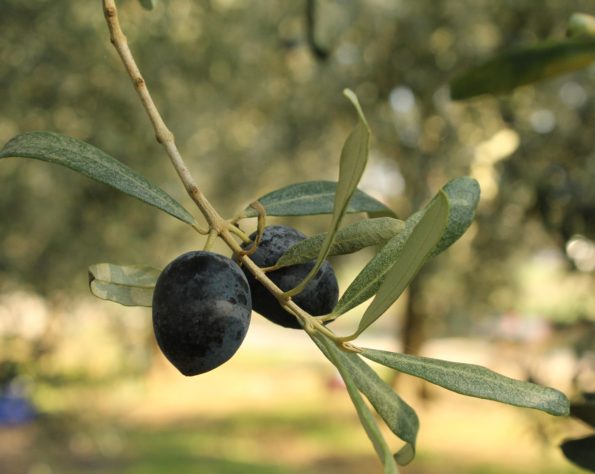 At least one style of olives is always served at kahvaltı, Turkish breakfast. When I first came to Turkey the thought of eating olives for breakfast seemed really strange, but it’s such an important part that I would try some each time and have really grown to love balancing out breakfast with the salty and delicious flavor of olives here. Olives are also an important garnish on many salads such as Çoban Salatası and Piyaz. Olive oil is very common in Turkey and not nearly as expensive as in the States, which makes sense since Turkey produces it right here. In fact, Turkey is the world’s fourth largest producer of olives. Spain is the largest producer, followed by Italy and Greece, then Turkey. Olives contain high amounts of good monosaturated fat and minerals such as iron and copper. They are also rich in vitamin E and other antioxidants.
At least one style of olives is always served at kahvaltı, Turkish breakfast. When I first came to Turkey the thought of eating olives for breakfast seemed really strange, but it’s such an important part that I would try some each time and have really grown to love balancing out breakfast with the salty and delicious flavor of olives here. Olives are also an important garnish on many salads such as Çoban Salatası and Piyaz. Olive oil is very common in Turkey and not nearly as expensive as in the States, which makes sense since Turkey produces it right here. In fact, Turkey is the world’s fourth largest producer of olives. Spain is the largest producer, followed by Italy and Greece, then Turkey. Olives contain high amounts of good monosaturated fat and minerals such as iron and copper. They are also rich in vitamin E and other antioxidants.
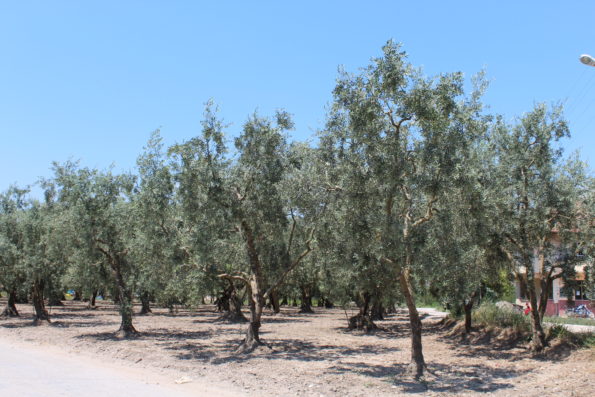 Since olives & olive oil are such an important part of Turkish life and cuisine, I wanted to learn more about them. An entire genre of Turkish cuisine is called zeytinyağlı which, literally translated, means “with olive oil”. Many of these dishes can be found under the “Salads and Side Dishes” category in the recipe section of this website. A large variety of side dishes that use olive oil as a key ingredient are offered at every restaurant and are a great source of importance and pride within Turkish cuisine. So, I visited Adatepe Zeytinyağı Müzesi (Adatepe Olive Oil Museum) in Çanakkale province a few months ago. They have great information and so much history printed out around the museum as well as old machinery. I took lots of notes and pictures and plan to write an article about that soon, so stay tuned! However, nothing compares to real life experience! I had the incredible experience of traveling to İznik, Bursa, to help harvest some olives right from the trees! (You may be more familiar with the English name for this town, Nicaea.) Although the Aegean & Mediterranean regions are more known for growing the olives which are good for making quality olive oil, this area is known for their many fields of olive trees that produce olives mainly good for eating. I was on a minibus for one hour traveling through all sorts of villages and going by many picturesque fields with squatty gray/green olive trees lining each side of the road. Below I will try to include all of the information I learned as well as some of my experiences while harvesting.
Since olives & olive oil are such an important part of Turkish life and cuisine, I wanted to learn more about them. An entire genre of Turkish cuisine is called zeytinyağlı which, literally translated, means “with olive oil”. Many of these dishes can be found under the “Salads and Side Dishes” category in the recipe section of this website. A large variety of side dishes that use olive oil as a key ingredient are offered at every restaurant and are a great source of importance and pride within Turkish cuisine. So, I visited Adatepe Zeytinyağı Müzesi (Adatepe Olive Oil Museum) in Çanakkale province a few months ago. They have great information and so much history printed out around the museum as well as old machinery. I took lots of notes and pictures and plan to write an article about that soon, so stay tuned! However, nothing compares to real life experience! I had the incredible experience of traveling to İznik, Bursa, to help harvest some olives right from the trees! (You may be more familiar with the English name for this town, Nicaea.) Although the Aegean & Mediterranean regions are more known for growing the olives which are good for making quality olive oil, this area is known for their many fields of olive trees that produce olives mainly good for eating. I was on a minibus for one hour traveling through all sorts of villages and going by many picturesque fields with squatty gray/green olive trees lining each side of the road. Below I will try to include all of the information I learned as well as some of my experiences while harvesting.
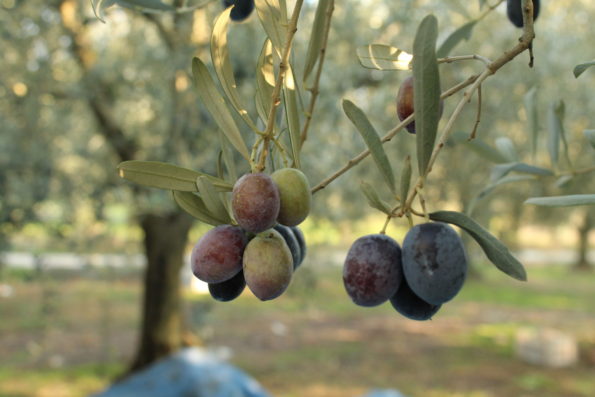 The trees I was helping to harvest were planted in the 1940s due to Greek influence. Before that time, growing olives in Turkey wasn’t such a large enterprise. Typically it takes between 3-5 years after a tree is planted to begin bearing fruit. I had always assumed that different olive varieties came from different trees, especially green and black. Actually, the difference comes in when olives are picked and how they are cured after picking them from the trees. Since olives can’t be eaten fresh from the tree, the process after harvesting is lengthy and done in a myriad of ways to get such a variety of olives that can be eaten. Green olives are picked from the tree before they are ripe, but black olives are allowed to stay on the tree until fully ripened. Although black olives give the most oil, adding some green olives enhances the oil with a fruity taste and makes it lighter. When we stopped for lunch break, the delicious salad that was served contained onions, tomatoes, cucumbers and black olives from last year’s harvest. Those olives were stored in an oak barrel with lots of salt and heavy stones on top which press the olives so the bitterness drains off and each olive is bursting with delicious flavor. Salt has three functions: preservation, edibility, and taste. Too much salt is not desirable for the taste, not enough salt risks that the olives go bad. The warmer the temperature the more salt is needed. Curious as to why the black olives I eat here are so much better than ones in the States, I asked the field owners. It’s not just the difference that here you need to be careful to eat around the pit with each olive. There really is no comparison between how these taste and the ones sold in a can in the States taste. I learned that naturally ripened olives are too soft to have the pits removed without being squashed. So the nicely pitted black olives in the States really are completely different from the olives here in that they were picked before ripening and then unnaturally changed to the black color during the curing process.
The trees I was helping to harvest were planted in the 1940s due to Greek influence. Before that time, growing olives in Turkey wasn’t such a large enterprise. Typically it takes between 3-5 years after a tree is planted to begin bearing fruit. I had always assumed that different olive varieties came from different trees, especially green and black. Actually, the difference comes in when olives are picked and how they are cured after picking them from the trees. Since olives can’t be eaten fresh from the tree, the process after harvesting is lengthy and done in a myriad of ways to get such a variety of olives that can be eaten. Green olives are picked from the tree before they are ripe, but black olives are allowed to stay on the tree until fully ripened. Although black olives give the most oil, adding some green olives enhances the oil with a fruity taste and makes it lighter. When we stopped for lunch break, the delicious salad that was served contained onions, tomatoes, cucumbers and black olives from last year’s harvest. Those olives were stored in an oak barrel with lots of salt and heavy stones on top which press the olives so the bitterness drains off and each olive is bursting with delicious flavor. Salt has three functions: preservation, edibility, and taste. Too much salt is not desirable for the taste, not enough salt risks that the olives go bad. The warmer the temperature the more salt is needed. Curious as to why the black olives I eat here are so much better than ones in the States, I asked the field owners. It’s not just the difference that here you need to be careful to eat around the pit with each olive. There really is no comparison between how these taste and the ones sold in a can in the States taste. I learned that naturally ripened olives are too soft to have the pits removed without being squashed. So the nicely pitted black olives in the States really are completely different from the olives here in that they were picked before ripening and then unnaturally changed to the black color during the curing process.
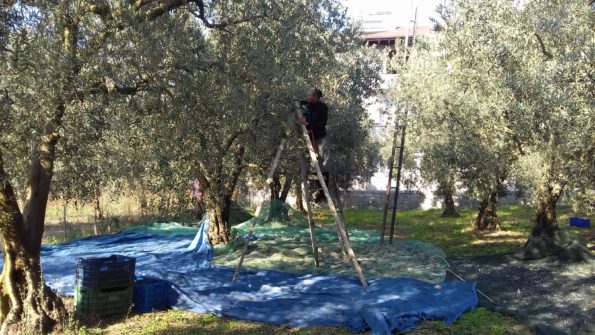 Pruning olive trees is crucial for a successful harvest. The trees we were harvesting were approximately 17-20 feet tall. Pruning is typically done in February or March. Trees blossom in April and May. The fragile white olive blossoms are very finicky. If there’s too much rain or hard rain, the blossoms will be damaged or blown off of the trees. If the days are very hot with the nights cooling down dramatically, that also ruins the blossoms. It’s often necessary to irrigate throughout Summer and Fall if the weather is dry. Harvest usually takes place in November. Ripe olives on the tree have a bluish hue and are the best for “black eating olives.” The olives we harvested from the trees, which still have a reddish purple hue or are green, were separated out for olive oil. It takes approximately 6-7 pounds of olives for one small 16 ounce bottle of olive oil!
Pruning olive trees is crucial for a successful harvest. The trees we were harvesting were approximately 17-20 feet tall. Pruning is typically done in February or March. Trees blossom in April and May. The fragile white olive blossoms are very finicky. If there’s too much rain or hard rain, the blossoms will be damaged or blown off of the trees. If the days are very hot with the nights cooling down dramatically, that also ruins the blossoms. It’s often necessary to irrigate throughout Summer and Fall if the weather is dry. Harvest usually takes place in November. Ripe olives on the tree have a bluish hue and are the best for “black eating olives.” The olives we harvested from the trees, which still have a reddish purple hue or are green, were separated out for olive oil. It takes approximately 6-7 pounds of olives for one small 16 ounce bottle of olive oil!
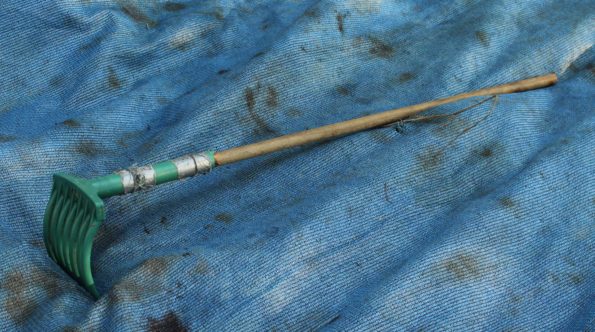 I’m sure olive harvesting is done differently in each place, but here’s what we did: Before starting, we spread netted tarps on the ground all around the first tree. I climbed a tripod ladder (as pictured above) to reach all of the low and medium branches. I used my hands – like milking a cow – to pick the olives within easy reach and let them fall to the ground and land on the tarps. I also used this special tool to rake the branches and knock the olives to the ground. Although each olive doesn’t ripen at the same pace, the majority was ripe and we didn’t need to be selective about which ones to pick. We just knocked all of them from the tree and then sorted them later. The men used very tall ladders and climbed branches as necessary to comb all of the olives from the tops of the tree. When one tree was done we would move on to the next. We carefully picked up all edges of each tarp so the olives collected in the middle and then we gently poured them into crates (as pictured below). It was very important when getting on and off the ladder or walking around to not step on any of the olives or they would squash easily and need to be thrown out.
I’m sure olive harvesting is done differently in each place, but here’s what we did: Before starting, we spread netted tarps on the ground all around the first tree. I climbed a tripod ladder (as pictured above) to reach all of the low and medium branches. I used my hands – like milking a cow – to pick the olives within easy reach and let them fall to the ground and land on the tarps. I also used this special tool to rake the branches and knock the olives to the ground. Although each olive doesn’t ripen at the same pace, the majority was ripe and we didn’t need to be selective about which ones to pick. We just knocked all of them from the tree and then sorted them later. The men used very tall ladders and climbed branches as necessary to comb all of the olives from the tops of the tree. When one tree was done we would move on to the next. We carefully picked up all edges of each tarp so the olives collected in the middle and then we gently poured them into crates (as pictured below). It was very important when getting on and off the ladder or walking around to not step on any of the olives or they would squash easily and need to be thrown out.
 By dusk on Saturday we had harvested seven trees. We gathered 12 crates of olives which is about 500 pounds! We then took all of the crates to a man who has a special machine to help us separate them. One crate at a time the olives were dumped into the top container and released a few at a time from the bottom onto a conveyor belt. The man running the machine worked quickly to pick out any green or not quite ripe olives and set them aside for olive oil. Then the olives dropped down to a level without a solid belt but rubber cords with small gaps in between which gradually got larger and larger. As the olives continued to move along the conveyor, the gaps allowed the smallest olives to drop through and come out a shoot on the side where they were deposited into another crate and someone else was there ready to remove stems still attached. As the cords gradually got larger, the olives were separated by size in the same manor into four different categories. I was in charge of the crate containing the largest olives so didn’t have quite as many fall into my crate, but still it was an important and back-breaking task to ensure only the highest quality olives remained in the crate, olives which would then be cured with salt and sold for eating.
By dusk on Saturday we had harvested seven trees. We gathered 12 crates of olives which is about 500 pounds! We then took all of the crates to a man who has a special machine to help us separate them. One crate at a time the olives were dumped into the top container and released a few at a time from the bottom onto a conveyor belt. The man running the machine worked quickly to pick out any green or not quite ripe olives and set them aside for olive oil. Then the olives dropped down to a level without a solid belt but rubber cords with small gaps in between which gradually got larger and larger. As the olives continued to move along the conveyor, the gaps allowed the smallest olives to drop through and come out a shoot on the side where they were deposited into another crate and someone else was there ready to remove stems still attached. As the cords gradually got larger, the olives were separated by size in the same manor into four different categories. I was in charge of the crate containing the largest olives so didn’t have quite as many fall into my crate, but still it was an important and back-breaking task to ensure only the highest quality olives remained in the crate, olives which would then be cured with salt and sold for eating.
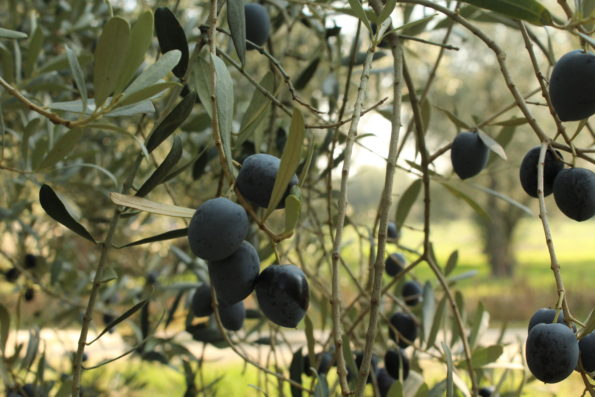 Since I’m a country girl at heart, raised on a farm and used to long days of good, hard work, I thoroughly enjoyed my day helping to harvest olives! Having lived in the big city now for almost 6 years my heart rejoiced after spending a day in the sunshine and dirt. However, the next day my muscles were complaining quite loudly about the experience. Since I only went for one day to help out and had to leave before we were done separating the olives so that I could catch a bus home before bed, I really had the best of both worlds as I got to learn and enjoy a new experience but wasn’t forced to stay and finish the entire harvest, separation and curing process the way actual olive farmers need to do. So while I came away from the day thrilled with the wonderful new adventure, I also gained a new appreciation for all the work that goes on before I easily pop an olive into my mouth or pour some olive oil while cooking. Scroll below to find many more pictures with captions explaining some more about olive growing and harvesting!
Since I’m a country girl at heart, raised on a farm and used to long days of good, hard work, I thoroughly enjoyed my day helping to harvest olives! Having lived in the big city now for almost 6 years my heart rejoiced after spending a day in the sunshine and dirt. However, the next day my muscles were complaining quite loudly about the experience. Since I only went for one day to help out and had to leave before we were done separating the olives so that I could catch a bus home before bed, I really had the best of both worlds as I got to learn and enjoy a new experience but wasn’t forced to stay and finish the entire harvest, separation and curing process the way actual olive farmers need to do. So while I came away from the day thrilled with the wonderful new adventure, I also gained a new appreciation for all the work that goes on before I easily pop an olive into my mouth or pour some olive oil while cooking. Scroll below to find many more pictures with captions explaining some more about olive growing and harvesting!
Unripened olives, photo taken in July
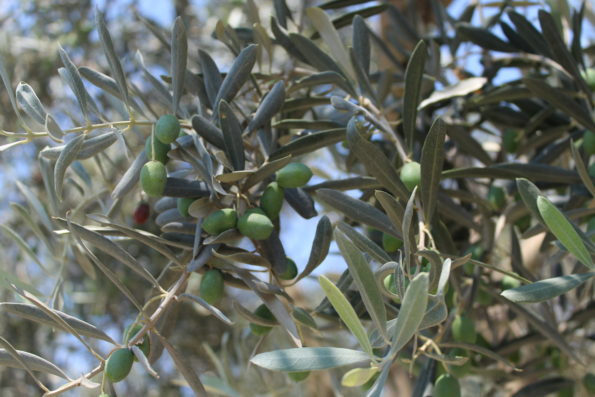
Close-up of unripened olives, photo taken in July
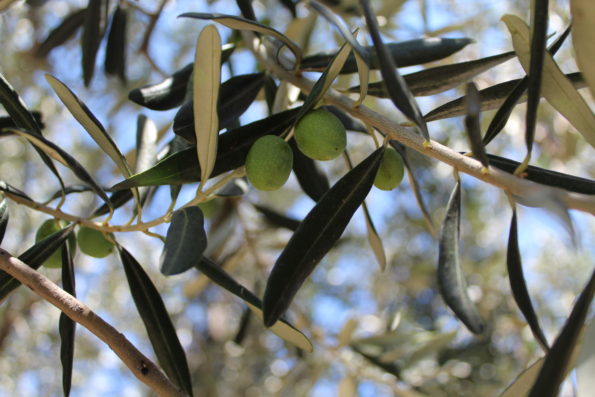
Freshly picked olives in the crate & ready to be sorted, photo taken in November
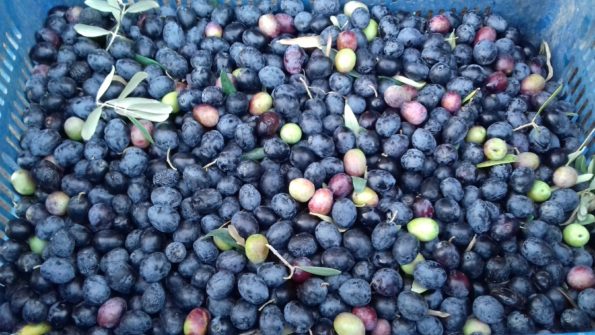
Unripened olives on same tree as harvesting ripe olives, photo taken in November
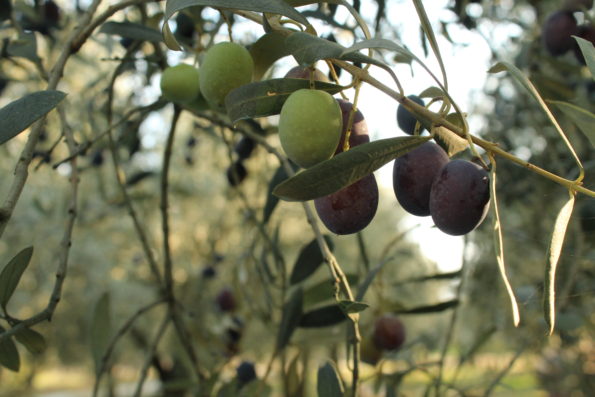
Ripened olives just before being picked, photo taken in November

Olive tree, tripod ladder used for picking, netted tarps used for catching picked olives

Olive grove at the end of harvest day, filled crates and many olives still on the netted tarp
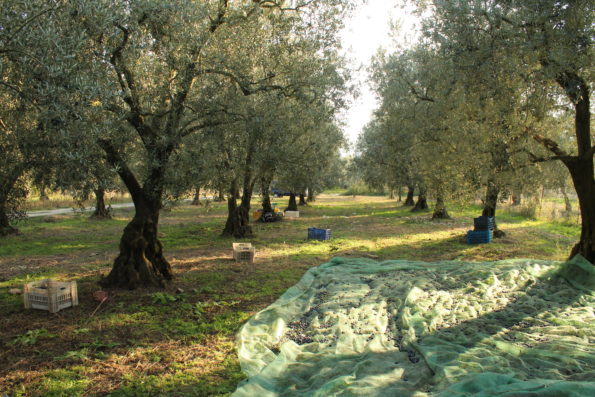
Photo taken at dusk on harvest day
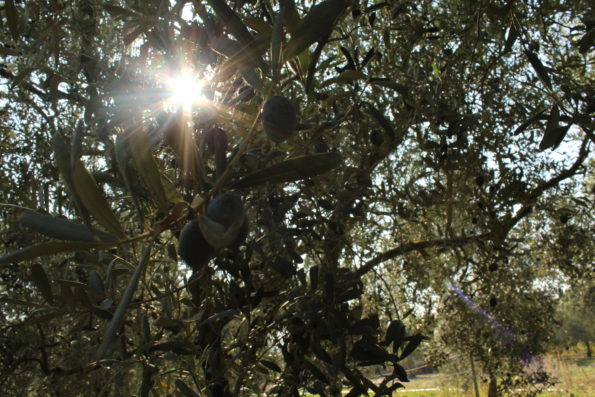



Julene
Wow; this was such a fascinating read! I learned so many things but it was written in a fun and interesting way!
Will
This is so fascinating. I didn’t realize that olives are so relatively new to Turkey.
And I can imagine your were in pain the next day – that sounds exhausting!
Deb
How interesting to learn all about olives & olive harvesting! My mouth is watering ~ I’ve gotten to enjoy olives in Turkey & they are one of my favorites!
Kevin
Thanks for the great pictures and informative article. I’m looking forward to exploring more of your articles and recipes.
Manfred and Debrah
Thank you for this lovely article and your help in the harvest, Jale. It was a joy to spend that day with you. The olives you helped harvesting are in large barrels now in salt water pressed under heavy stones in order to exchange the bitter substances in the olives with the salt to make them edible and tasty. Come back to try them when they will be done in late spring (or any time earlier!)
Jale
Yes, I will most definitely come back and taste those olives we harvested together! Thanks so much for including me in day and helping me learn so much! Was a really great experience!